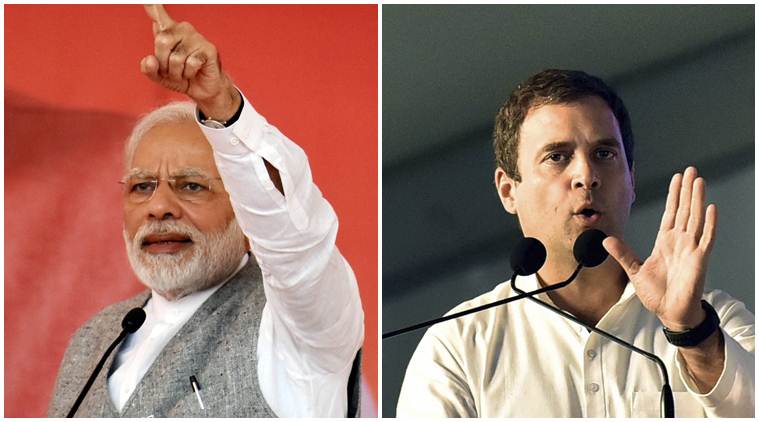
Both the BJP and the Congress manifestos are now in the public domain and we have had time to read and digest the core message from each of these. Beyond the instant headlines, can we glean some insights about the approach of each party from their flagship announcements?
Undoubtedly the flagship scheme of the Congress is the Nyuntam Aay Yojana (NYAY) and how it intends to tackle poverty. The Congress’ promise is that it will raise the family income of the poorest Indians from the present monthly average of Rs 6,000 to Rs 12,000. On the face of it, this looks like a winner and a sure shot method to eliminate poverty. But, how does the Congress intend to fund this scheme? After a lot of furore, their advisors have, at least for now, backed off from their proposal of raising taxes for the middle class. But they have still not backed off from their other proposal — of funding NYAY through an inflation tax.
What does inflation tax mean? Simply that, instead of the average two to three per cent inflation now under the Modi government, we will return to the double-digit inflation regime that we witnessed during the entire tenure of UPA-II. To understand what this means for the poor, consider the effect of inflation on purchasing power and prices. With average 10 per cent inflation for five years (as was witnessed during UPA-II), the purchasing power of Rs 12,000 — that the poor will get through NYAY in 2019 — will be reduced to just Rs 4,627 by 2024. The prices of essential commodities, on the other hand, would have multiplied exponentially. A product priced at Rs 100 today would be around Rs 161 after five years of average 10 per cent inflation. Effectively then, with the way it has been designed, the poor will be poorer after five years of NYAY. This is not just an incidental fallacy of this scheme, it is also reflective of the entire approach of the Congress in tackling poverty. A majority of their interventions, since the “Garibi Hatao” slogan in the 1970s, have been dole-based. By their very design, they do not empower the poor to create their own durable income earning opportunities. Instead, they are designed to keep the poor perpetually in subsistence mode, so that each election cycle they remain a catchment for new vote-seeking devices. That is why despite 40 years of Congress style “Garibi Hatao”, poverty has not been eliminated.
Now consider the BJP’s flagship interventions as promised in their manifesto. Rs 100 lakh crore worth of investment in infrastructure, 25 lakh crore investment in the agri-rural sector, up to 50 lakh collateral-free loans to ignite entrepreneurship and housing for all by 2022. None of these are doles. Instead, they are designed to kick-start an economic cycle of sustainable empowerment. An enterprising youth from a poor family who has an idea to build a sustainable business, but is held back due to lack of capital, can now avail the opportunity of collateral-free, low interest, bank loans. The economic empowerment that such a model brings, as has been proved world over, not only lifts people out of poverty but also progressively puts them in the middle-class category.
The Ayushman Bharat scheme, which intends to cover 50 crore people, is another such example. That poor families will no longer have to fear penury in case of any serious health emergency, is the obvious benefit. But the virtuous economic cycle that Ayushman Bharat will kickstart will, perhaps, be the biggest benefit of this scheme. There was always a demand for top quality health services in the villages and towns, but the paying capacity to meet this demand did not exist. With significant paying capacity now created in one go, the entrepreneurial genius of Indians will create the supply chains needed to meet this demand. High quality hospitals, wellness centers, trained doctors and other medical professionals will all be in demand, not just in the metros but in tier II and III cities and towns. This will create permanent employment which in turn will drive its own economic cycle of consumption and growth.
Building more than 60,000 kms of roads in the next five years, doubling of functional airports, ensuring tap water supply in every home, 24 hours power for every house, pension schemes for small shopkeepers in addition to unorganised workers, and, the promise to further rationalise taxes for the middle-class are some of the other ideas in the BJP manifesto. Curiously, the Congress manifesto is absolutely silent on the middle-class: Is it because of the intrinsic guilt that they will be at the receiving end of the vote gathering device of Congress?
In totality, the manifestos present two competing visions. The Congress manifesto, reflective of its dynastic culture, offers a vision of subsistence living for the masses with a benign dynast to look after their future. The BJP manifesto, reflective of PM Modi’s vision, seeks to provide an enabling environment to empower the genius of each individual and to take India to middle-income status by 2030. The choice is now upon us. The decision we make today will determine the future of our children tomorrow.
The writer is CEO, Bluekraft Digital Foundation and was earlier director (content) MyGov